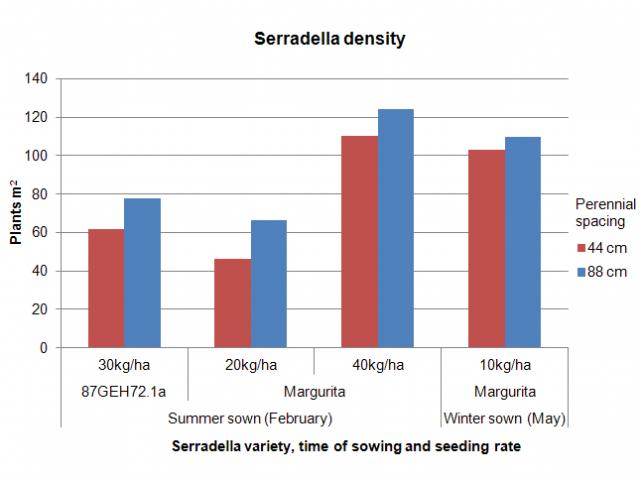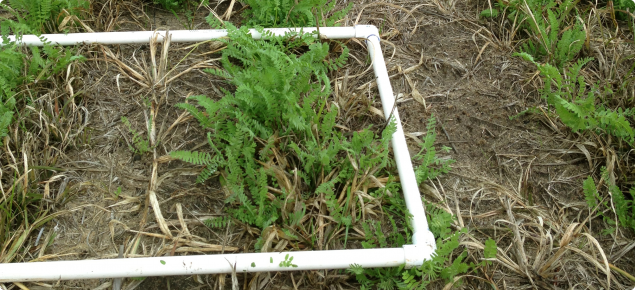Background
Sub-tropical grasses can transform deep sandy soils that are marginal for continuous crop production and prone to wind erosion.
Currently there are concerns about the ongoing productivity of perennial grass based systems due to inadequate nitrogen inputs.
A companion annual legume could provide nitrogen to drive productivity and improve feed quality of perennial grass pastures, however, sowing annual pastures in winter often conflicts with demands of a large annual cropping program.
Aim
To evaluate the feasibility of introducing French and yellow serradella into sub-tropical perennial pastures by sowing unscarified pod segments in summer (that is, summer-sowing technology).
To compare the performance of serradella pastures sown in February (summer-sowing pod) with serradella pastures sown after the break of season (as scarified seed).
To evaluate the impact of perennial row spacing and annual legume seeding rate on establishment, winter growth and seed production of serradella.
Trial details
| Property | Peter Negus, 20km south of Dandaragan |
|---|---|
| Soil type | Deep sand; soil surface (0-10cm) pH (CaCl2) 5.4, organic carbon 1.06% |
| Crop / variety | Margurita French serradella and unreleased yellow serradella line (87GEH72.1a) sown into established Gatton Panic and Katambora Rhodes grass plots |
| Paddock rotation | Volunteer pasture prior to sowing sub-tropical perennial pasture (2012) and serradella summer sown into perennial plots (2013) |
| Treatments | 10kg/ha Margurita (seed) winter sown over perennial rows 44cm apart 10kg/ha Margurita (seed) winter sown over perennial rows 88cm apart 20kg/ha Margurita (pod) summer sown (control) 20kg/ha Margurita (pod) summer sown over perennial rows 44cm apart 20kg/ha Margurita (pod) summer sown over perennial rows 88cm apart 40kg/ha Margurita (pod) summer sown over perennial rows 44cm apart 40kg/ha Margurita (pod) summer sown over perennial rows 88cm apart 30kg/ha 87GEH72.1a (pod) summer sown (control) 30kg/ha 87GEH72.1a (pod) summer sown over perennial rows 44cm apart 30kg/ha 87GEH72.1a (pod) summer sown over perennial rows 88cm apart |
| Sowing date | August 2012: perennial grass |
| Fertiliser (kh/ha) | 160kg/ha Super Potash sown with serradella pasture |
| Growing season rainfall | 529mm (May to October) 113mm of summer rainfall (January to April) |
Results
Perennial establishment
The perennial pastures sown in August 2012 established well and produced approximately 1t/ha over summer (January to April).
Serradella establishment
Establishment of winter sown French serradella was excellent with a germination density of over 100 plants/m2 in perennial pasture plots (Figure 1).
A summer seeding rate of 40kg/ha (pod) was necessary to achieve a similar density.
Although seedling density of the 20kg/ha treatment was half that of the 40kg/ha treatment by mid-August the biomass of these plots and winter sown treatment were comparable.
There was little difference in biomass and seed production of serradella sown as pod segments in February and scarified seed in May, however, serradella emergence was delayed relative to an annual-only pasture.

The impact of perennials on serradella production
There was lower biomass production when Margurita was summer sown into perennial pastures (Figure 2).
The unreleased yellow serradella line (87GEH72.1a) produced 600kg/ha more biomass than Margurita in monoculture (that is, no perennial base) but 600kg/ha less when sown into perennial grasses.
Perennial row spacing did not appear to have a significant effect on either serradella establishment, biomass or seed production (Figure 1 and 3).

Should seeding rate be increased when sowing into perennials?
Two summer (February) seeding rates of Margurita pod were evaluated: a medium rate of 20kg/ha and a high rate of 40kg/ha.
This was compared to a winter (May) seeding rate of 10kg/ha of seed.
Germination was very good (over 100 plants/m2) for the winter sown Margurita and plant, numbers were comparable to the high summer seeding rate (Figure 1).
But this did not flow through to greater biomass relative to the medium (20kg/ha) pod seeding rate.
There was little or no advantage from a high seeding rate (40kg/ha) of Margurita pod when compared to 20kg/ha pod or 10kg/ha of clean seed.
Although, the high seeding rate helped to achieve greater plant density and early biomass, by mid-spring the biomass for the high and medium seeding rates were both about 3.5t/ha and seed yield similar (Figure 4).

Conclusion
In this trial both summer sowing and conventional seeding after the break of the season resulted in the successful establishment of serradella into perennial grass pastures.
All treatments resulted in seed yields greater than 600kg/ha which has set them up for good regeneration in subsequent years.
Acknowledgements
Thanks go to Daisy and Peter Negus for hosting the trial and the DPIRD Geraldton Research Facility for sowing and managing the trial.
This research is being supported by the Caring for Our Country project Transforming the Northern Sandplain and GRDC through the Future Farm Industries Cooperative Research Centre Ltd’s EverCrop project (P2 FP09).



